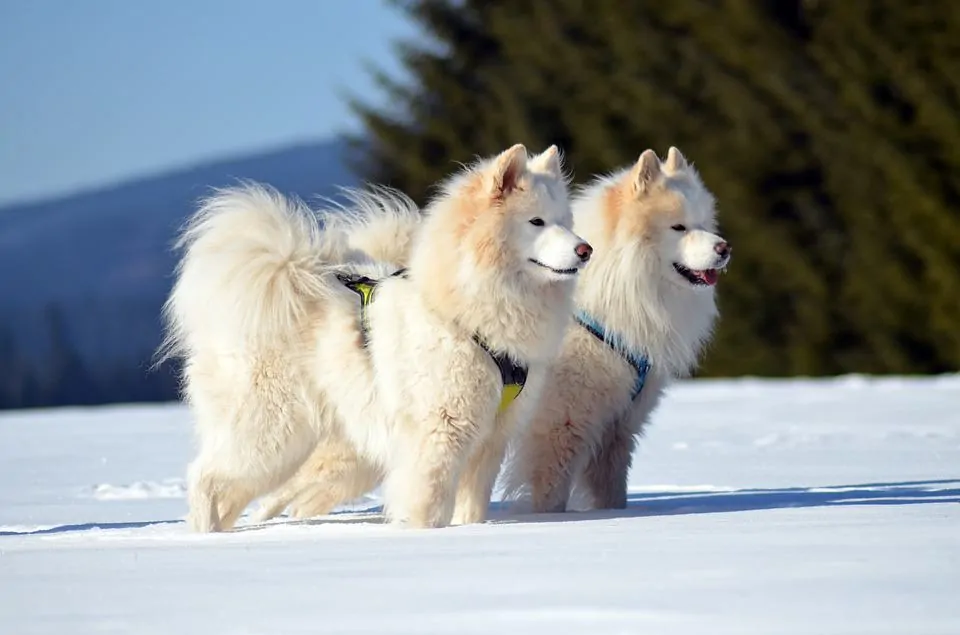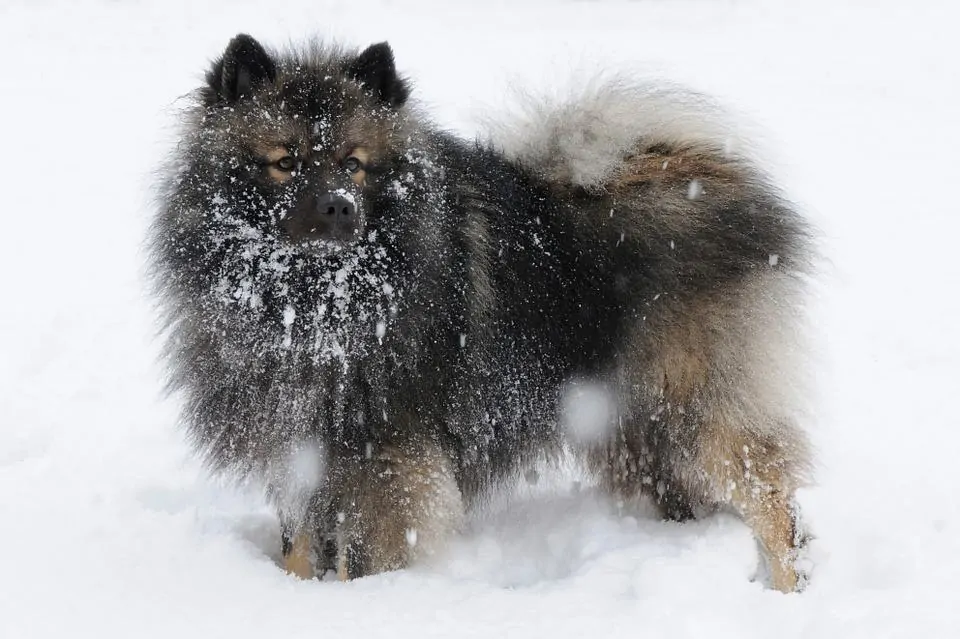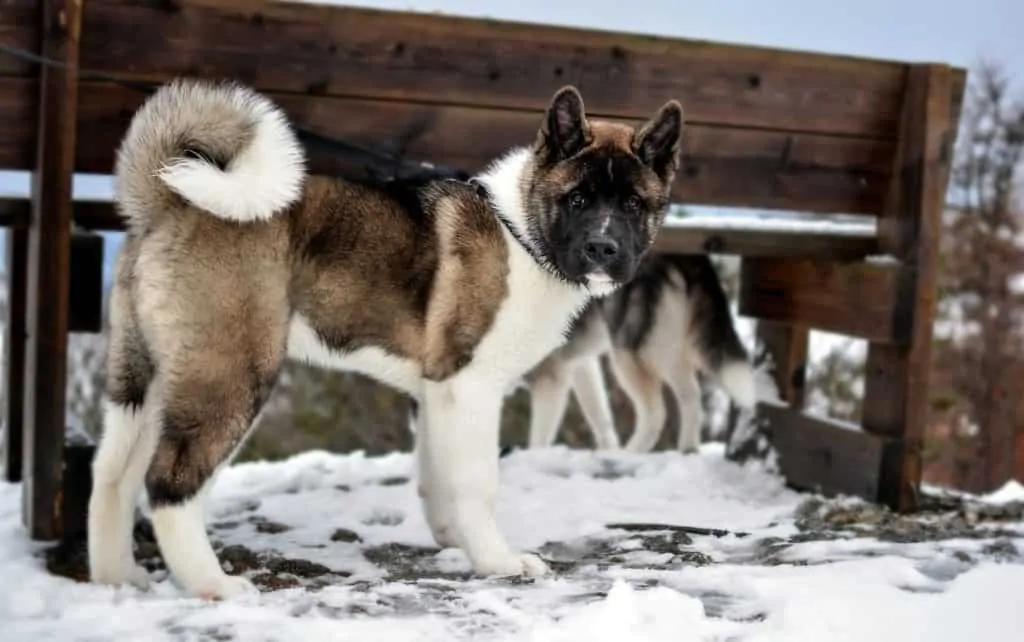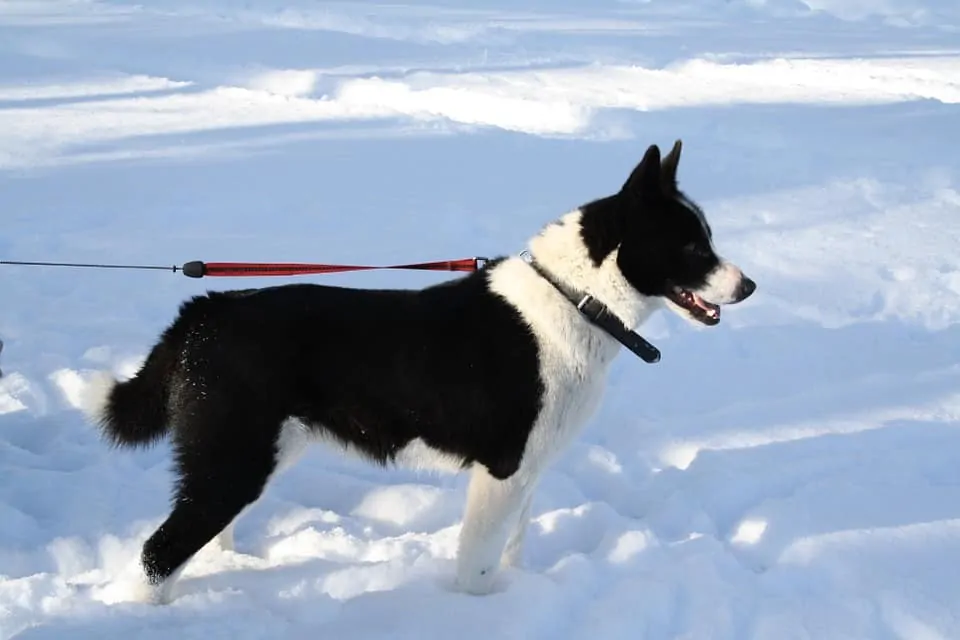Tight like a corkscrew. Lazily draped over the back like a bushy blanket. Spiraling just at the end. There are a lot of different types of curly tails in the canine kingdom with each breed having their own unique take on this eye-catching characteristic.
But one thing is true of each of these dogs with curly tails: those tails are adorable!
Here are 21 of the MOST adorable dog breeds with curly tails.
Contents
Basenji
With a unique foxy look, big round eyes, and a curly hind appendage that winds inward into infinity, there is no denying the Basenji’s cuteness.
In terms of strict curliness, it doesn’t get much tighter or more uniform than the corkscrew tail of the Basenji.
These unique dogs hail from Africa and date back to the times of the ancient Egyptians. They have been used for millennia to help their owners hunt for game in the dense forests of Central Africa and were first discovered by westerners in the Congo around 1895.
As pets, they can be a bit aloof and catlike. They are stubborn, independent and require a patient and consistent owner. Their smaller size, inability to bark, and lack of any discernible odor do make them a great choice for apartment dwellers.
Pug
Curly and velvety soft? It may not get any more adorable than that little pug rump.
Draped over the back with a tight curl in the end, it takes a lot to make the peppy Pug tail unfurl.
These well-known and much-loved little dogs were first bred in China, but made their way to Europe early on, around the 1500s. That cute, wrinkly face and velvety-soft coat made them popular among nobles, including Queen Victoria.
As pets in the modern-day, they retain all the great qualities that made them popular back then. They are loyal, gentle, and quiet companions perfect for families and individuals looking for a lap warmer and devoted companion.
Finnish Spitz
Like a perfect circle set on the hip, the Finnish Spitz’s tail is one of the easiest ways to tell this dog from the fox it resembles.
Originally bred as a hunting dog, there is hardly any game the Finnish Spitz couldn’t be used to track and chase. They would flush and catch small prey like birds and squirrels and were used to chase, track, and “bark point” larger game like moose and bears.
Today, many Finnish Spitz are still used as hunting hounds in their native Finland. In other parts of the world, they have found their way into the home where they make loyal but active companions and great siblings for children.
Shibu Inu
This type of dog’s tail is so curly that it has a second level! Plus it comes in a variety of colors from this red coat, to back, cream, and white.
Almost as curly and coiled as the Basenji tail and maybe cuter given the bushy hair that covers it, the Shiba tail is easily recognizable.
These smallest of the Japanese Spitz breeds were once used to hunt and flush game in the mountains of the Chubu region. Despite a devoted following, the Shiba Inu was almost lost to the world following an outbreak of distemper and a lack of resources after the Second World War. All Shibas alive today hail from the remaining three bloodlines discovered in the latter half of the 20th century.
Shiba’s are described as catlike and share many unique personality traits that are found only in other Spitz-type dogs. They are independent and need a consistent owner to keep them on the right path. They make great hiking companions and are the perfect dog for active individuals without a lot of space to spare.
Samoyed
A pair of brilliantly curly appendages with a waterfall of hair cascading down. It is hard to deny the majesty of this northern pup.
Arched over the back in a perfect “C,” the Samoyed tail is distinguished from other northern breeds by that beautiful, long white coat.
Originally bred to herd reindeer, this Spitz has a personality unique among northern breeds and shepherds. Their thick, double coat keeps them well insulated against the elements and makes them easy to pick out in a crowd.
Sammies are loyal, affectionate, and seemingly always happy. They make gentle companions for young children and are great for families. Their activity needs make them unfit for apartment living and they need plenty of stimulation to keep them smiling.
Icelandic Sheepdog
Like a fluffy flag held high over the back, the tail of the Icelandic Sheepdog may not be well known, but it is unquestionably adorable.
This ancient breed likely came to Iceland with the vikings early on and has been helping shepherds there gather sheep and cattle for centuries. Their thick coat and upbeat temperament were key to surviving in a climate so harsh that even the cattle are brought inside during the winter.
The Icelandic Sheepdog remains a rare breed today, with most still found within the island confines of the country. Which is a shame, because this happy-go-lucky dog has a winning personality, high intelligence, and the work ethic to take on just about any job.
Keeshond
The Keeshond’s rump is a tangle of beautiful silver hair, the lightest and wooliest of it belonging to that brilliantly curly appendage.
Covered in fluffy, thin hairs and held over the back, which is covered in much of the same, it is difficult to see exactly what is going on with the curly Keeshond tail.
This breed hails out of Holland and has a long and interesting history in the area. They were originally used by barge captains as companions and guard dogs. In the late 1700s, the Keeshond was adopted by the Dutch Patriot faction as a symbol for the people. Once the House of Orange took control of the political landscape, the breed was almost wiped from existence in the country.
Today, the Kees still happily fills the role of the doggy of the people by being a loyal, affectionate, and playful companion. They are quick learners and do well in a variety of environments and family units.
Norwegian Buhund
Curly, soft, and always happy to see their owners, the Buhund’s posterior can be a good gauge for how these protective but affectionate dogs are feeling.
Not as curly as many Spitz-type dogs, the Norwegian Buhund’s tail looks very similar to that of a husky’s.
The Bunhund is a herding Spitz breed originally used by Norwegian shepherds to gather and protect flocks in the harsh terrain of the coastland. They doubled as guardians of the homestead when not traveling the hills with the sheep.
These dogs form strong bonds with their owners but can be aloof with strangers. They are very intelligent and active and need to be exercised multiple times a day. They do best in environments where they can roam off-leash to burn off excess energy.
Norwegian Elkhound
The Norwegian Elkhound has a similar look to the Keeshond, but their shorter hair and tight, curly tail easily distinguish the two breeds.
Originally bred to hunt moose in Scandinavia, the Elkhound may be one of the bravest breeds in the canine kingdom. Their intimidating bark, athleticism, and willingness to chase an animal twenty times their size made them valuable companions to their Norse owners.
Today, these dogs are still highly prized for both their hunting and tracking skills as well as their loyalty and intelligence. They require an active home where they can spend plenty of time outdoors. They still love to bark and do not make great dogs for apartments or close quarters.
Pomeranian
Basically just an extension of their fluffy round body, the Pom’s curly tail often gets lost in that beautiful coat.
While it may be hard to identify this curly tail in all that poof, we assure you, it is there.
The Pomeranian descends from the larger German Spitz breed and was first bred in the region between Germany and Poland. This is another small breed that Queen Victoria took a liking to, which eventually led to the Pom’s popularity across Europe.
Today’s Pom is much smaller than the original breed, with some lines barely tipping the scales at three pounds. They tend to be very loving and playful dogs but, like many toy breeds, can be aggressive or barky with other dogs and strangers.
Chow Chow
Helpful for keeping their back warm and for making them look more confident and intimidating to trespassers and other dogs, the Chow’s curly tail was crafted with purpose.
Perhaps the puffiest of the curly tails, there is no mistaking the folded over Chow Chow tail.
The Chow Chow is an ancient breed that has been used for a number of purposes over the centuries including as a war dog, a sled dog, and as a source of food. The Chow’s thick coat protected them from the elements as much as from their enemies, both human and animal.
Today’s Chow retains much of the same ferocity as their ancestors. They are protective of their family and take time to warm up to strangers. Like many Spitz breeds, they tend to be more catlike than doglike.
Sweedish Vallhund
Some unique recessive genes mean that this typically curly-tailed breed can be born with no tail, a long tail, or any variation thereof.
Similar to the Corgi, the Vallhund was originally bred to herd cattle. In this profession, being short and bendy meant getting kicked by powerful livestock less often. In addition to their short legs, the Vallhund’s thick coat and high intelligence made them perfect for life in the unpredictable north.
The Val is still a rare breed but where it does exist, it is most often kept as a companion animal. Their athleticism and ability to learn quickly also make the Vallhund a great choice for agility and other dog sport competitions.
Akita
More of a loose curly tail, it is rare to see the Akita’s hind flag anywhere but settled over their hip. The appendage is as much an homage to their lineage as their unwavering confidence.
Unlike the similar-looking Husky, the Akita’s tail bends at the base to cover the back and rarely unfurls.
This Japanese dog has a colorful history. They were originally bred in the mountainous region of the north and used to hunt elk and bear. They were also a popular breed for dogfighting and were often kept by samurai.
In the modern-day, Akitas are used almost exclusively as companion animals. The ferocity needed to keep them safe in the fighting ring and while hunting large game is still intact, but these dogs are typically very loyal and loving with family. They make great guard dogs and require consistent training and plenty of early socialization.
Karelian Bear Dog
When honing in on game or building up their own confidence in preparation for chasing down a thousand pound brown bear, the Karelian’s tail often tenses and hangs straight. But once they take off after their prey it quickly stands at attention with that signature curly coil visible at the end.
The Karelian Bear Dog looks something like a cross between an Akita and a border collie, but with the curly tail of the former.
This Finnish breed came into existence more recently when hunters in the 1930s worked together to breed a dependable, versatile hunting dog capable of bringing down large game. Various hunting breeds native to the region of Karelia were used. The product was a fearless canine with the drive and instinct to chase down prey as large as moose and as fierce as bears.
The Karelian is still largely unknown outside of its home country, but there it is highly celebrated. While it has not gained much popularity as a companion in other countries, it has proven useful as a bear deterrent. Many companies and wildlife officers now use these Bear Dogs to scare problem bears away from high traffic areas in national parks and cities.
Swedish Lapphund
This curly tail resembles that of the Samoyed, but in a much darker shade.
The Swedish Lapphund descends from the ancient dogs kept by the Sami people of ancient Scandinavia. Like the Samoyed and Elkhound, this breed contains a key to their history locked in their genes: mitochondrial DNA from a female wolf that crossed with a domesticated dog centuries ago.
Unlike the white Samoyed who earned its keep as a herder, this black Sami dog was used primarily as a guardian and a hunter.
Today, the breed is kept as a companion, used by the military and search and rescue, and still used as a hunting hound.
American Eskimo Dog
The American Eskimo’s curly hind end (much like their front end) is a spitting image of the Sami’s, just miniaturized.
Held high over the back with confidence and grace, the white curly tail of the American Eskimo is as adorable a sight as the front end of this dog.
Not entirely an American breed and not at all an “Eskimo” breed, the American Eskimo isn’t a pup you can judge at the surface level. They hail from Germany originally, but their petite size and white coat were produced by fans of the breed in the US. Because they came to popularity shortly after the first World War, the name of the breed was changed from German Spitz to something more American.
Today’s AEDs still show traces of their unique history. They are prolific barkers like their guard dog forebearers and playful comedians like the circus AEDs so popular in the 1930s. They make great family dogs and pack a lot of energy into a small package.
Alaskan Malamute
Draped over their hip like an afterthought, the Mal’s hind appendage is curly when they are content and long and droopy when they are feeling lazy.
An elegant curl, like a question mark formed on the back, is the hallmark of this curly-tailed dog.
The large but graceful Malamute was bred by the indigenous people of Alaska to haul heavy cargo. They likely descended from the Siberian sled dogs of the previous era but are still an ancient lineage themselves. Their thick coat, large build, and intense work ethic made them perfect for their utilitarian existence.
Today, some Malamutes still compete in sled and weight pulling competitions, but most enjoy a more comfortable life. The Mal is a dependable companion with a steady disposition and affectionate temperament. They do well with families and are calmer than many working breeds.
Finnish Lapphund
With the curly tail of a Keeshond and the face of a wolf, this beauty is hard not to love.
While the name may be similar to the Swedish Lapphund, the personality and history of the Finnish Lapphund are closer to that of the Samoyed. These dogs were originally bred as herders by the Sami people and are still used for that purpose by reindeer keepers today.
While all are closely related, the three Sami breeds of Scandinavia are all slightly different. In the middle of the 20th century, when distemper and war threatened to erase all three breeds, a concerted effort was made to revive them by implementing strict breed standards that resulted in the different dogs we see today.
Siberian Husky
It’s not as curly as others, but the Husky’s rear still tells a tale about this northern breed’s origins.
While it is not uncommon to see the Husky tail trailing behind them like a flag in the wind, its tendency to curl over their back lands them a place on this list.
Like the Malamute, the Husky was originally bred for pulling sleds and cargo. They hail from ancient Siberia where they were kept by the Chukchi people. Life in this harsh climate was not easy and the Husky is living proof of that. They have a unique genetic mutation that allows them to exist on fewer calories than the typical dog of their size. This is one reason Huskies tend to be picky and inconsistent eaters.
Huskies are a popular breed for companionship all around the world. They still enjoy running, but most have traded the harness for a leash and the sled for a jogging companion. As long as they get enough activity, they make great family pets.
Canaan Dog
This breed’s long tail with the curl only at the end distinguishes them from the long list of Spitz breeds we’ve seen so far.
The Canaan Dog hails from the Middle East and was bred out of the pariah, or wild mongrel, dogs of the region. The Canaan Dogs were kept by the Bedouins and used as herders, guardians, and revered as sacred. Later on, when the Israelites were removed from their land, they left their dogs behind and they eventually returned to the wild.
In the 1930s, an animal behaviorist in the area was asked to build up a service dog organization for military and public use. She looked immediately to the intelligent wild dogs of the area, capturing and taming some. The puppies of these first tamed dogs were sold around the world and became the first to be officially called Canaan Dogs.
Eurasier
That curly little puff back there is only going to get more adorable as this Eurasier pup grows up.
The Eurasier looks like a cross between a Finnish Spitz and a Chow Chow and has the same adorable curly tail as both.
The Eurasier is a German breed that was first bred only sixty years ago. The intent was to create a dog with all the best qualities of a German Spitz and a Chow Chow. A little Samoyed was thrown in for character and the Eurasier was born.
As confident and protective as a Chow with the steady temperament and loyalty of a Spitz, the Eurasier makes a loyal family dog. They are aloof with strangers but never aggressive or fearful. While still uncommon outside of Germany, the beauty and temperament of this breed means we are only likely to see more of them.
Hope this guide on dogs with curly tails was helpful!

Jen Jones is a professional dog trainer and behavior specialist with more than 25 years of experience. As the founder of ‘Your Dog Advisor’ and the ‘Canine Connection’ rehabilitation center, she applies a holistic, empathetic approach, aiming to address root causes rather than merely treating symptoms.
Well known for her intuitive and compassionate approach, Jen adopts scientifically-proven, reward-based methods, encouraging positive reinforcement over punishment. Jen specializes in obedience training, behavior modification, and puppy socialization. Her innovative methods, particularly in addressing anxiety and aggression issues, have been widely recognized. Jen has worked with many of the world’s leading dog behaviorists and in her free time volunteers with local animal shelters and rescue groups.














